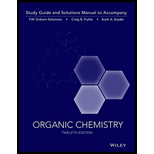
Interpretation:
The structures of D and E are to be deduced with the help of given information.
Concept Introduction:
Electrophiles are electron deficient species which has positive or partially positive charge. Lewis acids are electrophiles which accept electron pair.
Nucleophiles are electron rich species which has negative or partially negative charge. Lewis bases are nucleophiles which donate electron pair.
Free radical is an atom, molecule or ion that has unpaired electrons which makes it highly chemically reactive.
Substitution reaction: A reaction in which one of the hydrogen atoms of a hydrocarbon or a functional group is substituted by any other functional group is called substitution reaction.
Elimination reaction: A reaction in which two substituent groups are detached and a double bond is formed is called elimination reaction.
Addition reaction: It is the reaction in which unsaturated bonds are converted to saturated molecules by the addition of molecules.
The reaction in which hydrogen is added to the compound in the presence of catalyst is known as hydrogenation.
The number of moles of hydrogen absorbed will be equal to the number of double bonds.
Reduction is a process in which hydrogen atoms are added to a compound. Usual reagents used in the reduction process are
A reaction in which one of the hydrogen atoms of a hydrocarbon or a functional group is substituted by any other functional group is called a substitution reaction.
A reaction in which two substituent groups are detached and a double bond is formed is called an elimination reaction.
An addition reaction is a reaction in which unsaturated bonds are converted to saturated molecules by the addition of molecules.
Reduction is a process in which the addition of hydrogen atoms to a compound takes place.
Isomers are molecules which have same number of atoms but different arrangements of the atoms in space.
Stereoisomers have the same molecular formula, but the arrangement of atoms in the three-dimensional orientation is different.
Enantiomers are stereoisomers whose molecules have a chiral center and are mirror images of each other.
Diastereomers are stereoisomers that are not mirror images of each other. They are non-superimposable.
Molecules whose atoms are connected differently are called constitutional isomers.
Meso are those compounds whose molecules are superimposable on their image mirrors in spite of the presence of asymmetric carbon atom.
Chiral molecules are capable of rotating plane polarized light
The molecules which are superimposable or identical with their mirror images are known as achiral molecules, and achiral molecules are not capable of rotating the plane-polarised light.
Plane of symmetry is the plane that bisects the molecule in two equal halves, such that they are mirror images of each other.
Compounds having plane of symmetry are usually achiral as they do not have different atoms around the central carbon atom.
The stereoformula which is depicted in two dimensions, in which stereochemical information is not destroyed, is determined by the Fisher Projection formula.
Infrared spectroscopy is a simple, instrumental technique, which determines the presence of various
It depends on the interactions of atoms or molecules with the
Terminal
The molecules which have dipole moment are IR active and the molecules which do not have dipole moment are IR inactive.
Want to see the full answer?
Check out a sample textbook solution
Chapter 8 Solutions
Organic Chemistry, 12e Study Guide/Student Solutions Manual
 ChemistryChemistryISBN:9781305957404Author:Steven S. Zumdahl, Susan A. Zumdahl, Donald J. DeCostePublisher:Cengage Learning
ChemistryChemistryISBN:9781305957404Author:Steven S. Zumdahl, Susan A. Zumdahl, Donald J. DeCostePublisher:Cengage Learning ChemistryChemistryISBN:9781259911156Author:Raymond Chang Dr., Jason Overby ProfessorPublisher:McGraw-Hill Education
ChemistryChemistryISBN:9781259911156Author:Raymond Chang Dr., Jason Overby ProfessorPublisher:McGraw-Hill Education Principles of Instrumental AnalysisChemistryISBN:9781305577213Author:Douglas A. Skoog, F. James Holler, Stanley R. CrouchPublisher:Cengage Learning
Principles of Instrumental AnalysisChemistryISBN:9781305577213Author:Douglas A. Skoog, F. James Holler, Stanley R. CrouchPublisher:Cengage Learning Organic ChemistryChemistryISBN:9780078021558Author:Janice Gorzynski Smith Dr.Publisher:McGraw-Hill Education
Organic ChemistryChemistryISBN:9780078021558Author:Janice Gorzynski Smith Dr.Publisher:McGraw-Hill Education Chemistry: Principles and ReactionsChemistryISBN:9781305079373Author:William L. Masterton, Cecile N. HurleyPublisher:Cengage Learning
Chemistry: Principles and ReactionsChemistryISBN:9781305079373Author:William L. Masterton, Cecile N. HurleyPublisher:Cengage Learning Elementary Principles of Chemical Processes, Bind...ChemistryISBN:9781118431221Author:Richard M. Felder, Ronald W. Rousseau, Lisa G. BullardPublisher:WILEY
Elementary Principles of Chemical Processes, Bind...ChemistryISBN:9781118431221Author:Richard M. Felder, Ronald W. Rousseau, Lisa G. BullardPublisher:WILEY





